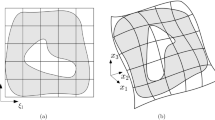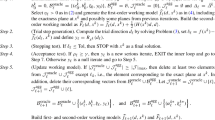Abstract
The paper analyzes a continuous and discrete version of the Neumann-Neumann domain decomposition algorithm for two-body contact problems with Tresca friction. Each iterative step consists of a linear elasticity problem for one body with displacements prescribed on a contact part of the boundary and a contact problem with Tresca friction for the second body. To ensure continuity of contact stresses, two auxiliary Neumann problems in each domain are solved. Numerical experiments illustrate the performace of the proposed approach.
Similar content being viewed by others
References
Alart, P., Curnier, A.: A mixed formulation for frictional contact problems prone to Newton like solution methods. Comput. Methods Appl. Mech. Engrg. 92, 353–375 (1991)
Avery, P., Farhat, C.: The FETI family of domain decomposition methods for inequality-constrained quadratic programming: application to contact problems with conforming and nonconforming interface. Comput. Methods Appl. Mech. Engrg. 198, 1673–1683 (2009)
Bayada, G., Sabil, J., Sassi, T.: Neumann-Dirichlet algorithm for unilateral contact problems: convergence results. C.R. Acad. Sci. Paris, Ser I 335, 381–386 (2002)
Bjorstad, P.E., Widlund, O.B.: Iterative methods for the solution of elliptic problems on regions partitioned into substructures. SIAM J. Numer. Anal. 23, 1097–1120 (1986)
Bayada, G., Sabil, J., Sassi, T.: A Neumann-Neumann domain decomposition algorithm for the Signorini problem. Appl. Math. Lett. 17, 1153–1159 (2004)
Chaudhary, A.B., Bathe, K.J.: A solution method for static and dynamic analysis of three-dimensional contact problem with friction. Comput. Struct. 24 (1986)
Dostál, Z.: Optimal quadratic programming algorithms: with applications to variational inequalities. SOIA, vol. 23. Springer, New York (2009)
Dostál, Z., Kozubek, T., Horyl, P., Brzobohatý T., Markopoulos, A.: Scalable FETI algorithm for two dimensional multibody contact problems with friction. J. Comput. Appl. Math. 235, 403–418 (2010)
Dostál, Z., Schőberl, J.: Minimizing quadratic functions over non-negative cone with the rate of convergence and finite termination. Comput. Optim. Appl. 30, 23–44 (2005)
Dyyak, I.I., Prokopyshyn, I.I.: Convergence of the Neumann parallel scheme of the domain decomposition method for problems of frictionless contact between several elastic bodies. J. Math. Sci. 171, 516–533 (2010)
Eck, C., Wohlmuth, B.A.: Convergence of a contact-Neumann iteration for the solution of two-body contact problems. Math. Mod. Meth. Appl. Sci. 8, 1103–1118 (2003)
Glowinski, R., Lions, J.L., Trémolières, R.: Numerical analysis of variational inequalities. North-Holland (1981)
Golub, G., Van Loan, C.F.: Matrix computations, MD. The Johns Hopkins University Press, Baltimore (1996)
Haslinger, J., Hlaváček, I., Nečas, J.: Handbook of Numerical Analysis, Elsevier Science (Eds. P.G. Ciarlet and J.L. Lions), vol. IV-part2, 313-485 (1996)
Haslinger, J., Dostál, Z., Kučera, R.: On a splitting type algorithm for the numerical realization of contact problems with Coulomb friction. Comput. Methods Appl. Mech. Engrg. 191, 2261–2281 (2002)
Haslinger, J., Kučera, R., Sassi, T.: A domain decomposition algorithm for contact problems: analysis and implementation. Math. Model. Nat. Phenom. 1, 123–146 (2009)
Haslinger, J., Kučera, R. , Sassi, T.: A domain decomposition algorithm for contact problems with Coulomb’s friction, submitted to Domain Decomposition Methods in Science and Engineering XXI Series: Lecture Notes in Computational Science and Engineering (2012)
Hüeber, S., Stadler, G., Wohlmuth, B.I.: A primal-dual active set algorithm for three-dimensional contact problems with Coulomb friction. SIAM J. Sci. Comput. 30, 527–596 (2008)
Ipopa, M.A., Sassi, T.: A Robin domain decomposition algorithm for contact problems: convergence results. Lect. Notes Comput. Sci. Eng. 70, 145–152 (2009)
Kikuchi, N., Oden, J.: Contact problems in elasticity. A study of variational inequalities and finite element methods. SIAM, Philadelphia (1988)
Klarbring, A.: A mathematical programming approach to three-dimensional contact problems with friction. Comput. Methods Appl. Mech. Engrg. 58, 175–200 (1986)
Koko, J.: Uzawa bloc relaxation domain decomposition method for a two-body frictionless contact problem. App. Math. Lett. 22, 1534–1538 (2009)
Krause, R., Wohlmuth, B.A.: Dirichlet-Neumann type algorithm for contact problems with friction. Comput. Vis. Sci. 5, 139–148 (2002)
Krause, R.: A non-smooth multiscale method for solving frictional two-body contact problems in 2D and 3D with multigrid efficiency. SIAM J. Sci. Comput. 31, 1399–1423 (2009)
Kučera, R.: Convergence rate of an optimization algorithm for minimizing quadratic functions with separable convex constraints. SIAM J. Optim. 19, 846–862 (2009)
Kunisch, K., Stadler, G.: Generalized Newton methods for the 2d-Signorini contact problem with friction in function spaces. Math. Model. Numer. Anal. 39, 827–854 (2005)
Laursen, T.A.: Computational contact and impact mechanics. Springer, London (2002)
Nečas, J.: Les methodes directes en theorie des equations elliptiques, Academia, Praha, and Masson et Cie, Editeurs, Paris (1967)
Riton, J., Sassi, T., Kučera, R.: On domain decomposition algorithms for contact problems with Tresca friction. Lect. Notes Comput. Sci. Eng. 78, 367–374 (2011)
Sassi, T., Ipopa, M.A., Roux, F-X.: Generalization of Lion’s nonoverlapping domain decomposition method for contact probs. Lect. Notes Comput. Sci. Eng. 60, 623–630 (2008)
Simo, J.C., Laursen, T.A.: An augmented Lagrangian treatment of contact problems involving friction. Comput. Struct. 42, 97–116 (1992)
Zavarise, G., Wriggers, P.: A superlinear convergent augmented Lagrangian procedure for contact problems. Engrg. Comput. 16, 88–119 (1999)
Author information
Authors and Affiliations
Corresponding author
Additional information
Communicated by: K. Urban
This work was supported by the European Development Fund in the IT4Innovations Centre of Excellence project CZ.1.05/1.1.00/02.0070 and by the grant P201/12/0671 of the Grant Agency of the Czech Republic. A part of this research was done in the frame of the ERASMUS programme.
Rights and permissions
About this article
Cite this article
Haslinger, J., Kučera, R., Riton, J. et al. A domain decomposition method for two-body contact problems with Tresca friction. Adv Comput Math 40, 65–90 (2014). https://doi.org/10.1007/s10444-013-9299-y
Received:
Accepted:
Published:
Issue Date:
DOI: https://doi.org/10.1007/s10444-013-9299-y




